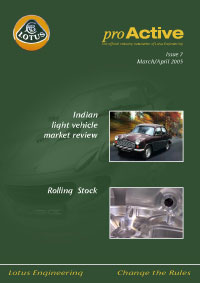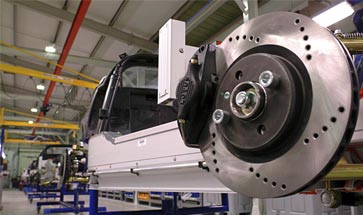ProActive Magazine from Lotus
proActive is the official industry newsleter of Lotus Engineering. This is issue 7, March / April 2005

Features
Indian light vehicle market review
Globalising the automotive supply chain
Rolling Stock
BOM Cost down: The Lotus Elise
Engineering composite structures
News
UK: Rising European demand for diesels spur technical developments
UK: Study says purchasing should be a strategic top level function
Russia: Government agrees in principle to auto parts duty cut.
BOM Cost down: The Lotus Elise
In 2001 Lotus Cars was losing money. Two new products - Elise âMark 2â and Opel Speedster/Vauxhall VX220 - had been launched, but they were proving too costly to manufacture. In the rush to bring the products to market, rigorous cost management had been a secondary priority. Furthermore, in comparison with the âMark 1â Elise, improvements in performance and additional feature content had lead to an increase in the bill of material (BOM) cost for the âMark 2â Elise. This increase in cost could not unfortunately be matched by an increase in the selling price - although market demand for the cars was high, the market could not take a selling price increase without a significant drop in sales volumes. For the business to survive and prosper, costs had to be reduced. The BOM represented by far the biggest cost-cutting opportunity.
The business faced a serious challenge to restore Lotus Cars to profitability quickly. The base Elise BOM cost had to be reduced by 10% within 12 months. As a further constraint, to meet the companyâs cash targets, payback on the investment made was required within 12 months. A BOM cost down programme was proposed, with the target of making the project cash neutral within the 2001-02 financial year. The targets were extremely aggressive, but nobody was in any doubt as to the seriousness of the situation.
The targets were quickly agreed upon (not without some trepidation from the programme leaders). Selwyn Mould, Head of Supply Chain, was asked to lead the team, while Clive Dopson, (at the time) Manufacturing Director, was appointed Programme Champion. A budget was fixed for all the key parts of the programme, such as: labour, tooling, engineering support, travel, and test & development. A dedicated team was recruited with a mix of skills: sourcing specialists to find new lower cost suppliers, buyers to set up contracts and place orders, cost engineers, designers, supplier quality engineers, database administrators and a project manager. An initial brainstorming session produced a list of cost saving opportunities, which was quickly supplemented by the findings of a comparative teardown (disassembly) of the Elise and Speedster/VX220 vehicles. At this stage over 50 opportunities were identified.
Once the opportunities were identified, they were categorised as follows:
- Negotiation with current supplier
- Re-source possibilities locally (Western Europe)
- Re-source possibilities globally
- Cost and value analysis to determine optimum ` manufacturing process and target pricing
- Re-engineering for new design, manufacturing process or material
- Deletion of part or feature
[Some opportunities fitted into more than one box but, for simplicity, each opportunity was filed under a single category.]
The opportunities were then prioritised based on: cost saving, time to fully implement, required cost of investment, and risk/expectation of success. Ten opportunities were selected for immediate action (although this list was added to) and an individual was appointed to own (manage) each opportunity. A savings target and a âtime to implementâ target was set for each opportunity and a weekly Boardwalk (project meeting) was convened to review progress, set continuing programme direction and remove roadblocks.
Initially progress was slow. Suppliers were reluctant to volunteer price downs. Many of the other opportunities required time to find new suppliers or to engineer cheaper solutions, let alone work through the rigorous âAPQPâ (Advanced Product Quality Planning) process that Lotus uses to validate new components. It was quickly realised that early success would only come from negotiation with current suppliers, supported by detailed cost analysis of the components supplied. A target list of suppliers was drawn up and negotiations were begun.
Whilst attempting to be fair and constructive, the Lotus negotiators left the suppliers in no doubt that the survival of the business was at stake and that the price down was an imperative necessity. Most suppliers responded positively. Many recommended changes to designs or processes, or asked why some materials were used when cheaper materials were available. In addition, treatments or finishes were deleted or downgraded to an appropriate level. In some cases Lotus cost engineers worked closely with suppliers to understand the true build up of costs in their processes and agree realistic target costs for the components supplied. Production engineers suggested improvements to shop floor layouts and manufacturing processes that would also deliver cost savings.
Relationships with some suppliers were not always entirely harmonious. One small supplier company, for whom Lotus was a major customer, was asked in negotiations for a 30% cost down across the range of parts it supplied. The target saving was based on a detailed analysis of what should be possible, backed up by a quick benchmarking exercise on a few parts. However the supplier did not believe he could afford the cost down, and did not have the necessary skills or resources to make the improvements required. Lotus promised to support this supplier with a dedicated production engineer whilst the improvements were implemented, however insisted on the full 30% cost down immediately. The supplier agreed after negotiations. Four years later that supplier now supplies Lotus with parts representing a bigger value per car, has benefited competitively from spreading its new manufacturing efficiency practice to the rest of its business, grown its business and has reduced its reliance upon Lotus.
The early savings obtained from negotiations with suppliers served to bankroll the project and ensure that it would meet its target of being cash neutral in the financial year. As the year progressed savings from other categories began to be delivered. Components from South Africa were introduced, in some cases offering savings of 50% over those replaced. A rule of thumb began to take shape and experience showed that the return on investment available differed quite markedly from savings category to category. Negotiation was a low investment activity, only requiring a negotiator. It provided fast results and the team could deal with many opportunities at once. Re-sourcing on the other hand often required investment in new tools, required support from SQA (Supplier Quality Assurance), took far longer to implement (3 to 6 months) and meant that the team could only handle a few opportunities at one time. Savings from cost analysis required limited investment, but did take time (3 to 6 months) to gather and analyse all the data. Re-design and re-engineering was the most expensive activity by far, needing expensive engineers and, most often, new tools. It often took up to 12 months to deliver a saving, but these savings could be large. Component & feature deletion was another category where investment was often low and implementation could be quick, depending on the provision of good component obsolescence control and pro-active marketing.
As the programme progressed the team developed a toolbox of techniques to identify and deliver cost savings. The vehicle/system teardown was often the starting point for opportunity identification. Benchmarking, designs being sent out to a range of suppliers for quotation, was another tool put to good use by the team. These quotes identified the market competitiveness of current suppliers and helped to determine the size of the opportunity. Benchmarking can, however, be overused and unless suppliers believe that there is definite potential to win business, they will not always provide a properly prepared, practical offer. The teamâs cost engineers spent many hours developing realistic cost models of components in their value engineering activity. This process found opportunities for savings by identifying those costs that were out of line with industry norms. To realise cost savings through negotiation, the team often sought to give more business to successful suppliers and so use the volume benefits gained to allow a price down. This also led to a rationalisation of the supply base, reducing transaction costs to Lotus and making supplier development easier.
The teardown process referenced above also highlighted opportunities for component commonisation/rationalisation across the Elise and Speedster/VX220 ranges. The extra component volume generated allowed further price reductions. There were also clear opportunities to optimise component manufacturing processes and to choose more suitable and cost effective materials for some components. The original âMark 1â Elise had been designed for a target annual volume of 700 - the combined annual volume of Elise and Speedster/VX220 was now approaching 6000. Many components in the new cars had been carried over from the earlier car. This represented a major opportunity. In a further intervention, Lotus cost and production engineers worked closely with suppliers to optimise factory layouts and help them incorporate a system based on lean manufacturing philosophy. Design and re-engineering also played a part, and design for manufacturing (DFM) techniques were used to improve quality and reduce cost.
Not least of all the tools employed was Lotusâ global sourcing knowledge. Focussing initially on re-sourcing from South Africa, Malaysia and, later on, India, substantial savings were made. The risks of lengthening its Supply Chain and dealing with new suppliers were considerable, but by carefully managing quality and choosing capable partners for logistics, savings were delivered with minimal disruptions to production. (Note: A further article will deal in depth with Lotus Global Sourcing experience).
When the first year of the programme drew to an end, the team had more than achieved its 10% BOM reduction target. In addition, the programme had not just been cash neutral but had delivered savings worth more than two and half times the programme investment within the financial year. As a result the programme was extended into year 2 and later on into year 3. Overall Lotus has now made savings worth more than 20% of the base BOM, with further savings on options equivalent in value to another 10% of the base BOM.
| Savings Table by Category | Time to implement | Size of investment |
| Negotiator | Fast | Low |
| Re-source | Medium | Medium |
| Cost Analysis | Medium | Low |
| Re-Engineer | Slow | High |
| Deletion | Fast | Low |

